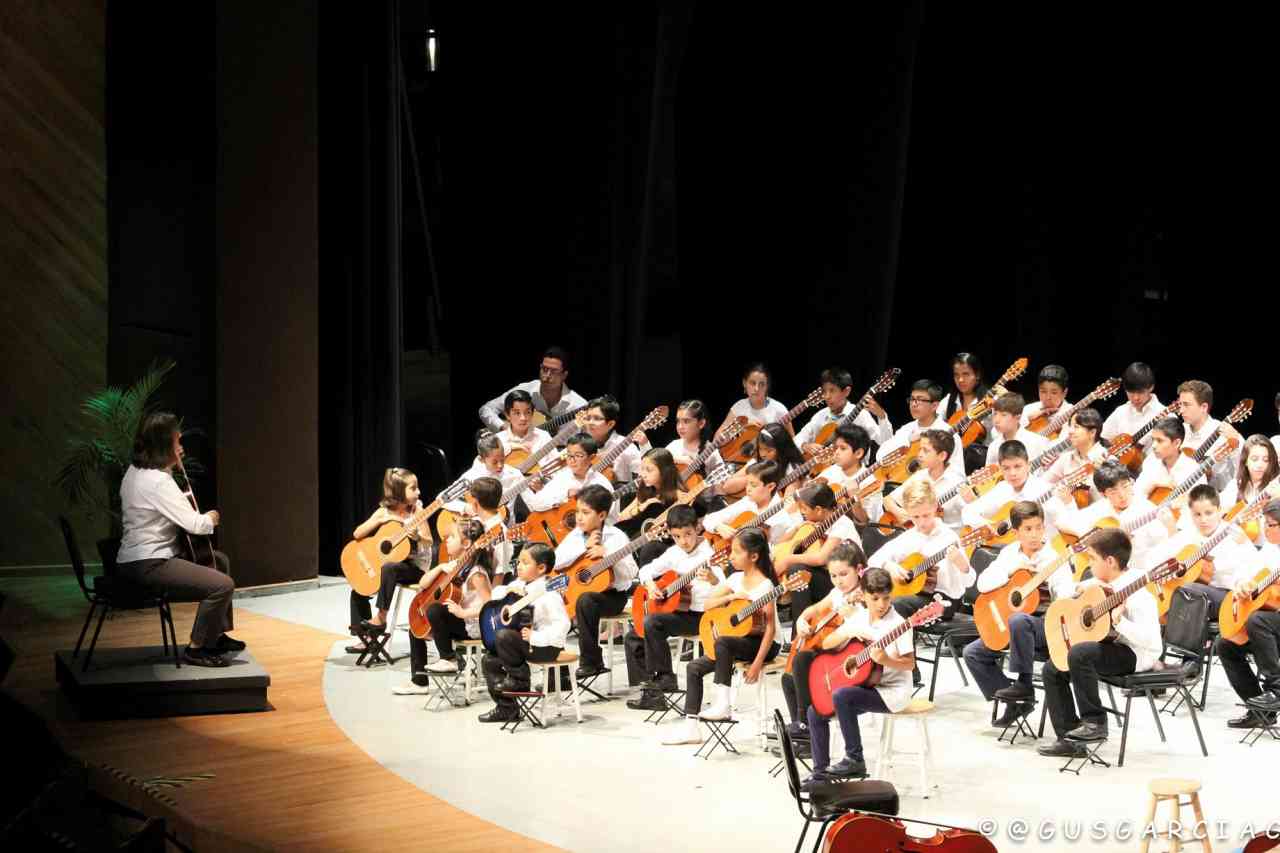
Guitarists, led by MaryLou Roberts, perform at the 2nd Mexican Suzuki Encuentro in May 2015.
2do Encuentro Mexicano Suzuki: Formando comunidad
“La música es un camino muy enriquecedor que genera encuentros que, en una manera muy particular, disminuye el “yo” para aceptar el “tú”;se hace borroso asimismo para incluir al grupo que escucha o crea la música. Por lo tanto, la música es muy efectiva para formar una comunidad: un grupo de personas que se identifican, se comunican y crecen por medio de sonidos singulares que, en un entorno específico, reconocen como “su música”.
El Segundo Encuentro Mexicano del Método Suzuki es una magnífica oportunidad para transformar una comunidad ordinaria en una extraordinaria, caracterizada por la esperanza, la justicia, la felicidad y el cultivo de música maravillosa por los niños y jóvenes de nuestro país…”—Dr. Gabriel Pliego
Del 30 de abril al 4 de mayo, tuvo lugar el Segundo Encuentro Mexicano Suzuki, en la hermosa ciudad histórica de Morelia, estado de Michoacán, México.
Cuatrocientos cincuenta y dos estudiantes del método Suzuki y sus familias asistieron, provenientes de 19 estados y 65 escuelas, instituciones y academias alrededor de todo México. También asistieron más de 100 maestros, acompañando a sus estudiantes o a tomar el curso de Filosofía Suzuki.
Tuvimos el honor y el privilegio de contar con un grupo de los mejores maestros del método Suzuki a nivel mundial, así como la visita de Pam Brasch, directora ejecutiva de la SAA (Asociación Suzuki de las Américas).
Caroline Fraser impartió el curso de Filosofía Suzuki, Fay Adams, Mary Craig Powell, Fracoise Pierredon y Naomi Kusano ofrecieron clases maestras individuales de piano. Christie Felsing, Susan Baer, Carol Waldvogel and Augusto Diemecke dieron clases grupales de violin. MaryLou Roberts, impartió clases grupales de guitarra; Carey Cheney, clases grupales de cello; Merret Bitticks, clases grupales de flauta.
También tuvimos el honor de contar con el director mexicano de coros, Ernesto García Velasco “Tato”, quien enseñó a todos los estudiantes, de seis años en adelante, un total de 400 niños, y con Georgina Gómez, especialista en Dalcroze, quien tuvo a su cargo a los niños de cinco años y menos. Además contamos con pianistas acompañantes y traductores/intérpretes para cada maestro que lo requiriera, algunos locales y otros que viajaron de diferentes ciudades del país.
La sede principal y el centro de operaciones fue el Conservatorio de las Rosas, el primer conservatorio construido en toda Latinoamérica. El Teatro Ocampo, el Teatro Morelos, el Auditorio Niños Cantores, del Conservatorio, y la Casa de la Cultura, prestaron sus espacios y escenarios para las diferentes presentaciones y recitales.
Morelia resultó ser el escenario ideal para el Encuentro. Por una parte, la cercanía de pocas calles entre el conservatorio, los teatros, los hoteles y las diferentes sedes donde se impartieron las clases, facilitó la movilización de todos los participantes de un lugar al otro, un gran acierto de logística. Además, disfrutando de la belleza de los edificios coloniales y centenarios de una ciudad reconocida por la UNESCO como Patrimonio Cultural de la Humanidad.
Actividades para maestros
Se realizaron dos actividades principales para maestros:
Retiro pedagógico Suzuki: Durante un día entero los maestros asistentes compartieron información sobre sus programas de formación Suzuki. Veinte maestros presentaron lo más destacado de sus escuelas, sus trayectorias, sus éxitos, metas y desafíos.Un resumen de estas exposiciones fue elaborado y compartido con todos los participantes.
Una serie de factores fueron reconocidos como esenciales para el desarrollo de programas exitosos:
-
Maestros cada vez mejor entrenados
-
Incluir el entrenamiento a los padres desde el principio
-
Tener los instrumentos y accesorios correctos para cada programa desde el comienzo, esencial para tener estudiantes motivados y exitosos.
-
Proveer un entorno bien preparado en casa y en las escuelas.
Otros aspectos destacados fueron:
-
Una modalidad diferente: Programas especiales de música desarrollados por una de las escuelas, dirigidos a niños en extrema pobreza y situación de alto riesgo. En este tipo de programas se recaudan fondos tanto del gobierno como del sector privado, a través de diversas actividades desarrolladas por voluntarios.
-
Inclusión de niños y jóvenes adultos con diferentes discapacidades.
-
Programas de música prenatal, para iniciar la estimulación desde el vientre materno.
Se habló además de la Asociación Mexicana Suzuki y su presidente, el Dr. Gabriel Pliego, compartió una presentación sobre cómo aplicar diferentes inteligencias para enseñar con éxito y para formar mejores seres humanos que se preocupan por sus semejantes. Nuestra mentora, Caroline Fraser, compartió una presentación acerca de los programas Suzuki en América Latina y de la importancia de ser incluyentes y cooperativos entre los países. También se mencionó que México ha sido un motor importante en las actividades Suzuki de América Latina.
Asimismo la ocasión fue propicia para destacar el Décimo Aniversario de la Asociación, y dar un merecido reconocimiento a la familia Diemecke, Augusto, Etna and Jilma Diemecke y la madre de ellos, Carmen Rodríguez, fundadores originales de la Asociación Mexicana Suzuki, junto con la maestra Caroline Fraser y con Gabriel Pliego.
Curso de Filosofía Suzuki: Durante todo el encuentro se desarrolló el curso de Filosofía Suzuki, a cargo de la maestra Caroline Fraser, con la participación de 33 personas. Quienes lo tomaron por primera vez comentaron con entusiasmo cómo el curso les había cambiado por completo la perspectiva de enseñanza musical.
Las clases maestras con los alumnos sirvieron como parte del curso, como prácticas de observación.
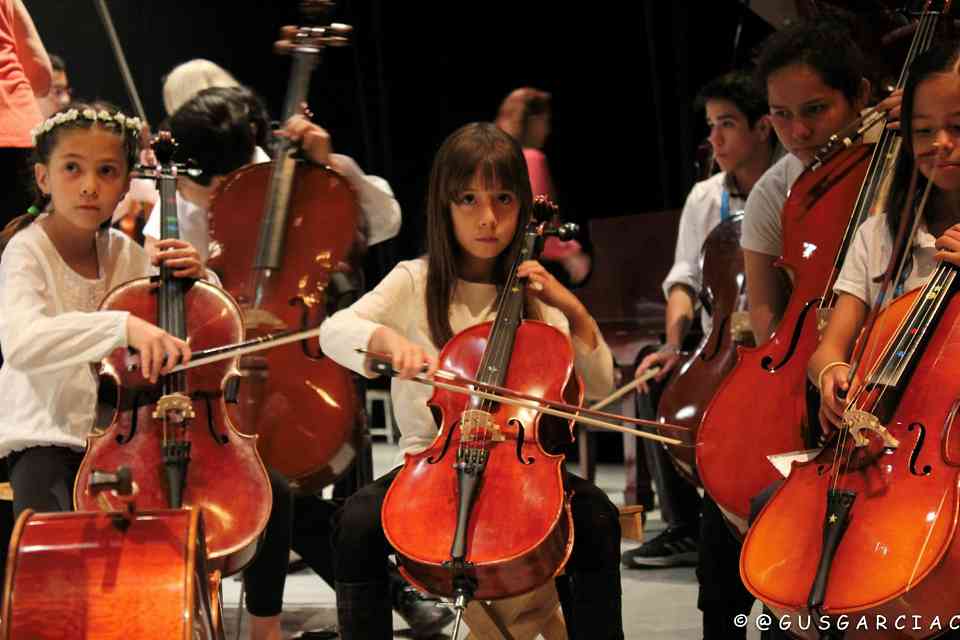
Cellists perform at the 2nd Mexican Suzuki Encuentro in May 2015.
Actividades con niños:
Clases maestras con alumnos
Durante tres días se impartieron cientos de clases maestras. Cada estudiante recibió cuatro clases maestras, algunas grupales, otras individuales, más cuatro ensayos corales, o sesiones de Dalcroze, dependiendo de su edad.
Recitales preparados por las escuelas
Se realizaron 24 recitales de escuelas, con la participación de todos los alumnos. Se presentaron pequeños grupos y grandes orquestas, ¡algunas inclusive de hasta 70 estudiantes! Algunas de las interpretaciones fueron realmente maravillosas, con un nivel técnico y musical muy alto, y las agrupaciones principiantes, dieron lo mejor de su esfuerzo y energía.
Los resultados: recitales y presentaciones
Los recitales de piano se realizaron el último día del encuentro, por la mañana, en el auditorio del Conservatorio, sobre cuyo escenario se presentaron sesenta y nueve estudiantes, para tocar cada uno una pieza sugerida por los maestros. Se dividieron en dos recitales, uno con 37 alumnos y otro con 32. Los recitales se llevaron a cabo de manera bella y fluida, mostrando el progreso adquirido en las clases maestras; todos los estudiantes tocaron con una gran sonrisa y verdadera determinación, y los padres estaban encantados por este maravilloso evento. También los chiquitos presentaron lo que aprendieron en el curso de Dalcroze.
Mientras se realizaba el recital de piano, todos los ejecutantes de violín, cello, flauta y guitarra (360 estudiantes) se reunieron para un gran ensayo en el Teatro Morelos, con el apoyo de un amplio grupo de maestros y personal del evento, ¡un esfuerzo de equipo titánico!
Más tarde los pianistas se unieron al ensayo de coro, para formar un grupo de 430 alumnos en el escenario. Una colorida masa de niños de todas las edades todos cantando juntos, ¡una vista fabulosa! Todos alistándose para la última presentación, la clausura, esa misma noche.
Celebracionesy mucha música
El programa del 2do Encuentro Mexicano Suzuki incluyó una serie de eventos especiales con la participación de artistas profesionales, una agrupación folklórica invitada, estudiantes y maestros.
La apertura del Encuentro se realizó la noche del 1° de mayo. Cerca de 800 personas se reunieron en el magnífico edificio del siglo XVIII llamado la Casa de la Cultura. El encuentro fue inaugurado oficialmente por la maestra Mary Craig Powell, seguida de un grupo de músicos y bailarines folklóricos que interpretaron la danza tradicional “Danza de los Viejos” donde los bailarines usan máscaras y bastones al son de una música muy animada. En un punto de la presentación los artistas invitaron a estudiantes, maestros y padres a unírseles en la danza lo que convirtió la presentación en una celebración general muy divertida y especial. Se ofrecieron dulces típicos mexicanos y hubo sonrisas y risas para todos.
La noche del 2 de mayo estuvimos encantados de tener una presentación profesional a cargo de tres grandes artistas que pertenecen al grupo “Concertistas de Bellas Artes”. Este bello concierto tuvo lugar en el Teatro Morelos, el teatro más importante de la ciudad. La soprano Irasema Terrazas y el barítono Gabriel Navarro acompañados por el destacado pianista mexicano y maestro Suzuki Santiago Piñeirúa, ofrecieron un programa muy variado que incluyó piezas de Granados, Puccini, Poulenc, Giménez, Moreno Torroba, Lloyd Weber, Schumann y María Grever, por mencionar algunos.
En la noche del 3 de mayo todos los estudiantes y sus familias y maestros, así como nuestros maestros invitados, nos reunimos en el atrio de la catedral para ofrecer un “play in”, lo que llamamos el “SuzuStreet”; un concierto ofrecido por los estudiantes Suzuki a sus familias, transeúntes, turistas y la comunidad de Morelia, con piezas para violín, cello, guitar y flauta, así como algunas piezas corales. ¡Una noche realmente inolvidable!
Clausura
En la noche del 4 de mayo se realizó la clausura del 2do Encuentro Mexicano Suzuki la cual comenzó a las 7:00 pm, con un auditorio lleno, casi mil personas en el público. Leslie Mizrahi y Etna Diemecke fueron las maestras de ceremonia, representando a la mesa directiva de la Asociación Mexicana Suzuki. Todas las interpretaciones del concierto fueron extraordinarias, comenzando con un bello programa de las guitarras, seguido por la actuación solista de un violinista de 11 años, Mariano García Valladares, quien ofreció una notable ejecución de la Meditación de Massenet. Después siguieron interpretaciones de las violas y los cellos.
El Estudio Suzuki Guadalajara nos entregó la maravillosa presentación de Sara Mendoza Quezada, la primera estudiante de Arpa Suzuki en México.
Después tuvimos bellas actuaciones de flauta y del grupo de pre-twinklers.
La Sra. Pam Brasch nos honró en el escenario con gentiles palabras y felicitaciones a nombre de la Asociación Suzuki de las Américas, y expresó su satisfacción por la masiva participación, las actividades tan exitosas y los bellos espacios que fueron parte del encuentro.
Entonces, un gran grupo de cerca de 300 violinistas llenaron el escenario, para ofrecer una presentación extraordinaria en muchos niveles.
Después tuvimos nueve ejecutantes de piano, seleccionados por los cinco maestros invitados para tocar una pieza cada uno, representando el extenso grupo de estudiantes de piano. Disfrutamos piezas de los libros del 1 al 6.
Terminamos con un gran coro conformado por todos los estudiantes de todos los instrumentos, cuatrocientos treinta y seis voces, llenas de sonrisas y energía, todos ellos bajo la dirección del fantástico“encantador de niños” Ernesto García Velasco “Tato”.Ellos nos ofrecieron una hermosa interpretación de cuatro bellas canciones incluyendo una pieza muy emotiva compuesta por el Dr. Suzuki, “Wishing” (Deseando), que representa el triángulo Suzuki, la relación entre el niño, sus padres y el maestro, donde él deseaba que los padres dieran la bienvenida a la filosofía dentro de sus vidas.
El 2do Encuentro Mexicano fue un gran éxito. La magia de hacer música y la alegría de compartir maravillosas experiencias quedará para siempre en nuestros corazones, almas y nuestros recuerdos.
Al final esperamos haber ayudado a transformar una comunidad ordinaria en una extraordinaria.
¡Hasta la próxima!
Agradecimientos especiales:
Agradecemos a muchas personas e instituciones por la realización de este extraordinario evento. En primer lugar, al Gobierno de la Ciudad de Morelia, el gran equipo del Departamento de Arte y Cultura del ColegioCedros-Universidad Panamericana: Armando Cárdenas, Jorge Martínez, Rafael García Vera, Carlos Ascencio, Juan Carlos Laguna. El personal del Conservatorio de las Rosas, en especial el decano Luis Jaime Cortez y el secretario general Froylán Melchor; la Coordinación Nacional de Música y Ópera del Instituto Nacional de Bellas Artes y la junta directiva de la Asociación Mexicana de Suzuki, quienes aportaron su tiempo y corazón en la realización de este evento nacional:Gabriel Pliego, Leslie Mizrahi, Etna Diemecke, Ricardo Salinas, Alvaro Sánchez, Daniel Duarte, y los delegados: Daisy Amador, Martha Ceballos y Lorena Leal.
Nuestro especial agradecimiento y reconocimiento para los maestros – tanto incitados como locales, y por supuesto a los estudiantes, sus dedicadas familias y profesores, el inspirador triángulo Suzuki que hace posible la magia.
¡Muchas gracias a todos!
2nd Mexican Suzuki Encounter: Forming Community
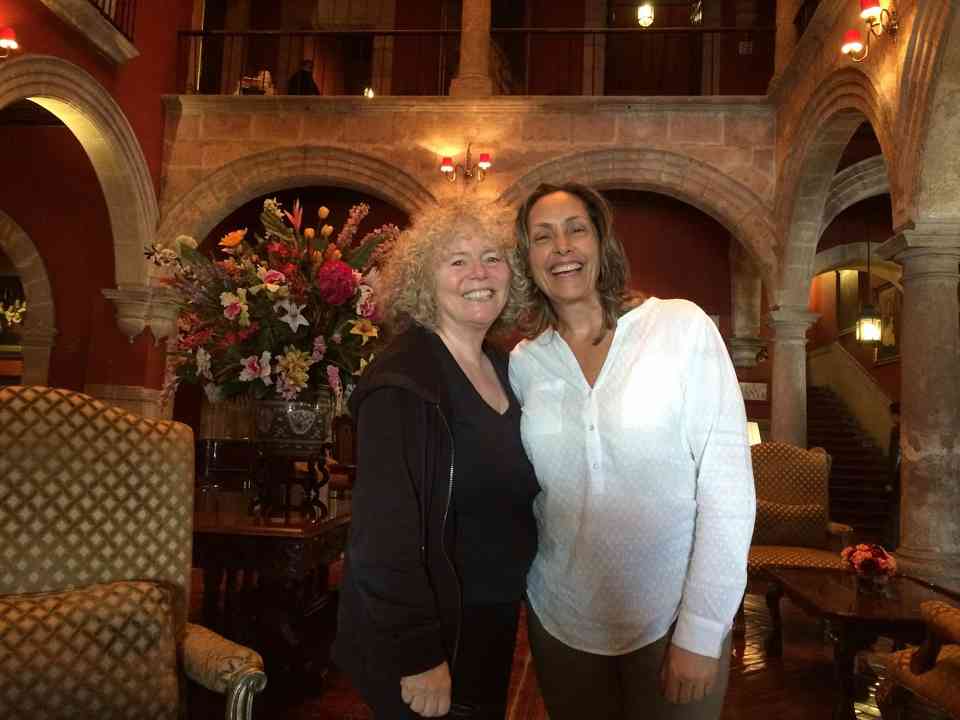
Caroline Fraser and Leslie Mizrahi
“Music is a very enriching path that generates encounters that, in a very particular manner, decrease the ‘I’ in order to accept the ‘you’; the line becomes blurred between the group that is listening and the group creating the music. Therefore, music is very effective for forming a community: a group of people that identify, communicate and grow by way of unique sounds that, in a specific surrounding, they recognize as ‘their music.’
The Second Mexican Encounter of the Suzuki Method is a magnificent opportunity to transform an ordinary community to an extraordinary one, characterized by hope, justice, happiness, and the fostering of marvelous music by the children and youth of our country …”
–Dr. Gabriel Pliego
From April 30 to May 4, 2015, the 2nd Mexican Suzuki Conference took place in the beautiful historical city of Morelia, State of Michoacán, Mexico.
Four hundred and fifty-two Suzuki students and their families attended, coming from nineteen different states in the country and from sixty-five schools, institutions and academies throughout Mexico. We also had the attendance of over one hundred teachers that either accompanied their students or came to take the Suzuki Philosophy course.
We were honored and privileged to have some of the best Suzuki teachers worldwide, as well as a visit of the SAA Executive Director, Pam Brasch.
Caroline Fraser taught the Suzuki Philosophy course with thirty-three participants in attendance. Fay Adams, Mary Craig Powell, Fracoise Pierredon and Naomi Kusano gave individual piano master classes. Christie Felsing, Susan Baer, Carol Waldvogel and Augusto Diemecke gave violin group lessons. MaryLou Roberts led guitar group lessons, and Carey Cheney, cello group lessons. Merret Bitticks taught flute group lessons. We also had the honor of having the Mexican choir teacher and conductor, Ernesto García Velasco “Tato” who taught all students six years old and up, a total of four hundred children, and Georgina Gómez, Dalcroze specialist, who taught the kids five years old and younger. We had accompanists and interpreters for every teacher that required them, some local and some others that traveled from different cities in the country.
The main venue and headquarters of the conference was the Conservatorio de las Rosas, the first conservatory to be built in all of Latin America. Also the Teatro Ocampo, the Teatro Morelos, the Auditorio Niños Cantores (the conservatory auditorium) and the Casa de la Cultura (the House of Culture) lent their spaces and stages to the different presentations and recitals.
Morelia turned out to be the perfect setting for the conference. The walking distance between the conservatory, the theaters, the hotels and the various classroom facilities made it very easy for everyone to go from one place to the other, while enjoying the beauty of the colonial and centennial buildings of a city recognized by UNESCO as Cultural Heritage of Humanity.
It was the perfect setting for this magnificent national conference.
Activities for Teachers
Two major activities for teachers took place.
Suzuki pedagogical retreat: During a whole day the participating teachers shared information about their Suzuki teaching programs. Twenty teachers showcased highlights of their schools, their trajectories, their successes, goals and challenges. A summary of their presentations was shared with all the participants.
A series of factors were recognized as essential in the development of successful programs:
-
Better trained teachers
-
Including parents’ training from the very beginning
-
Having the correct instruments and accessories for each program from the beginning, as a critical part in having motivated and successful students
-
Making sure the environment is well prepared at home and at the schools
Some other aspects stood out.
-
A different modality: Special music programs developed by one of the schools, aimed for children in extreme poverty and high risk situations. In this program funds are raised both from the government and the private sector, involving different fund raising activities by the volunteers.
-
Inclusion of children and young adults with different disabilities.
-
Prenatal music programs, starting stimulation from the mother’s pregnancy.
We also talked about the role of the Mexican Suzuki Association, and its president, Dr. Gabriel Pliego, shared a keynote presentation on how to apply different intelligences into teaching successfully to shape better human beings who care for others. Our mentor Caroline Fraser gave a presentation on Latin America’s Suzuki programs and how important it is to be inclusive and cooperative between countries. It was also mentioned that Mexico has a very active part in the Latin American Suzuki activities.
It was also a good opportunity to celebrate the Association’s tenth anniversary and give a special recognition to the Diemecke family, Augusto Diemecke, Etna Diemecke, Jilma Diemecke and their mother, Carmen Rodríguez, original founders of the Association, along with our mentors Caroline Fraser and Gabriel Pliego.
Suzuki Philosophy Course: Taught by Caroline Fraser, it was attended by thirty-three people and took place through the whole duration of the Encuentro. Those who took it for the first time talked with enthusiasm about how the course had completely changed their views on musical teaching. The master classes with children were part of the course as observation exercises.
Activities with Children
Master Classes with Students
Hundreds of master classes were given during three whole days. Each student received four master classes either in a group or individually, plus four choir rehearsals, or Dalcroze sessions, depending on their age.
Recitals Prepared By the Schools
Twenty-four school recitals took place with the participation of all the students. We had performances by small groups and large orchestras; some even had up to seventy students! Some of them were really amazing performances with a high level both technically and musically, and beginners’ groups gave their best effort and energy.
The Results: Recitals and Presentations
Piano recitals took place on the morning of the last day of the Conference at the “Auditorio Niños Cantores” inside the Conservatory, where sixty-nine students performed one piece each, suggested by the teachers. Performances were divided into two recitals: the first one with thirty-seven students and the second one with thirty-two students. Recitals went fluently and beautifully, showing the progress acquired in their master classes, all students performed with big smiles and true determination, and parents were delighted by this wonderful event. Also, the youngest children presented what they learned in the Dalcroze course.
While the piano recital was going on, all the violin, cello, flute and guitar players—360 students—gathered at the Morelos Theater for a great rehearsal, with the help and coordination of a very large team of teachers and staff—a titanic teamwork effort!
Later the pianists joined for the choir rehearsal to form a group of four hundred and thirty students on stage. A colorful mass of children of all ages, all singing together, a fabulous vision! All were getting ready for the last performance, the closure, that same night!
Celebrations with A Lot Of Music
The activity program of the 2nd Mexican Suzuki Conference included a series of special events with the performance of professional artists, a guest folk ensemble, students and teachers.
The opening of the Encuentro was offered on the night of May 1. Close to eight hundred people gathered in a magnificent building from the 18th century called the House of Culture (Casa de la Cultura). The event was officially inaugurated by Professor Mary Craig Powell, followed by a group of folk musicians and dancers who performed the traditional dance “The Dance of the Old People,” where the dancers use masks and canes moving to lively music! At one point of their performance they invited students, teachers and parents to join in for a very fun and special celebration! Mexican candy was offered and there were laughter and smiles from everyone.
On the night of May 2, we were delighted to have a professional performance by three great artists that are part of the “Concertistas de Bellas Artes.” This beautiful concert took place at the Morelos Theater, the city’s major theater. The soprano Irasema Terrazas and the baritone Gabriel Navarro accompanied by the outstanding Mexican pianist and Suzuki teacher, Santiago Piñeirúa, offered a very varied program which included pieces from Granados, Puccini, Poulenc, Giménez, Moreno Torroba, Lloyd Weber, Schumann and María Grever, to mention some.
On the night of May 3, all students and their families and teachers, as well as all of our guest teachers, gathered at the cathedral’s atrium to offer a play in, what we called the “SuzuStreet”; a concert offered by our Suzuki students to their families, by passers, tourists and the Morelia’s community, performing beautiful pieces for violin, cello, guitar and flute as well as some choir pieces. A truly unforgettable evening!
On the night of May 4, the closure of the 2nd Suzuki Mexican Encuentro started at 7 p.m., with a full auditorium of almost a thousand people in the audience. Leslie Mizrahi and Etna Diemecke were mistresses of ceremony, representing the board of the Mexican Suzuki Association. All performances were outstanding, starting with a beautiful program by the guitars, followed by a solo violin performance by eleven-year-old student Mariano García Valladares, who offered a wonderful performance of Massenet’s Meditation. He was followed by beautiful performances by the cellos and violas.
The Estudio Suzuki Guadalajara, the first one with a Suzuki Harp program in Latin America, gave us the wonderful performance of Sara Mendoza Quezada, Mexico’s first Suzuki Harp student. After that we had lovely performances by the flutes and the Pre-Twinklers group.
Mrs. Pam Brasch honored us on stage with very kind words and congratulations on behalf of the Suzuki Association of the Americas, expressing her satisfaction for the massive participation, successful activities and beautiful venues that were part of the encounter.
Then a very large group of around three hundred violinist filled the stage, to offer us an extraordinary performance on many levels.
Next we had nine piano players chosen by the five guest teachers to perform one piece each, representing the extensive group of piano students. We enjoyed pieces from Book One through Book Six.
We finished with a very large choir made of all the students of every instrument, four hundred and thirty six voices full of smiles and energy, all of them under the direction of the fantastic “Children Whisperer” Ernesto García Velasco “Tato.” They offered us an outstanding performance of four beautiful songs including a very touching piece by Dr. Suzuki, “Wishing”, which represents the Suzuki Triangle, the relationship between the child, his parents and the teacher, where he wished for the parents to welcome his philosophy into their lives.
The 2nd Mexican Encounter was a great success! The magic of music making and the joy of sharing marvelous experiences will stay forever in our hearts, souls and in our memories. In the end we hope we have helped to transform an ordinary community into an extraordinary one.
Until next time!
Special Thanks:
There are so many people to thank for the making of this extraordinary event. First of all the Government of the city of Morelia; and the great team of the department of art and culture of Cedros-Universidad Panamericana: Armando Cárdenas, Jorge Martínez, Rafael García Vera, Carlos Ascencio, Juan Carlos Laguna. The staff from the Conservatorio de las Rosas, especially its dean Luis Jaime Cortez and the general secretary Froylán Melchor, and the National Coordination of Music and Opera of the National Institute of Fine Arts and the board of directors of the Mexican Suzuki Association who gave their time and heart into the realization of this national event: Gabriel Pliego, Leslie Mizrahi, Etna Diemecke, Ricardo Salinas, Alvaro Sanchez, Daniel Duarte and the delegates: Daisy Amador, Martha Ceballos, Lorena Leal.
Our special gratitude and recognition goes to the teachers, both guests and local, and of course to the students and their dedicated and supportive families and teachers, the inspiring Suzuki triangle that makes magic possible.
Many thanks to everyone!

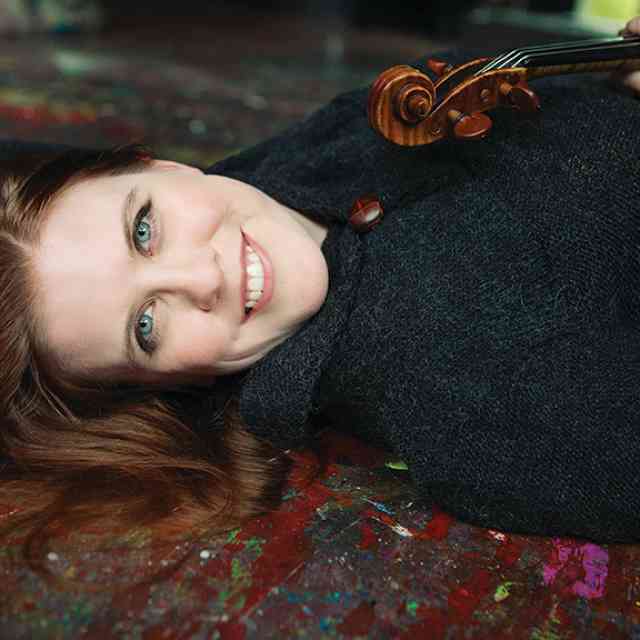
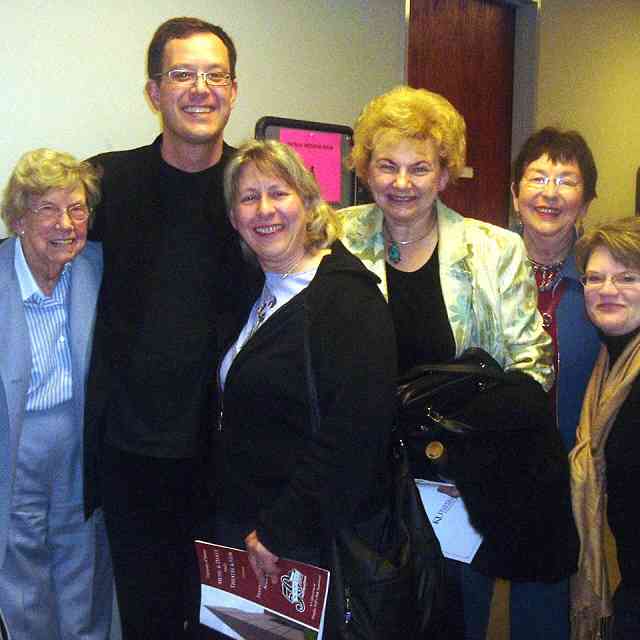
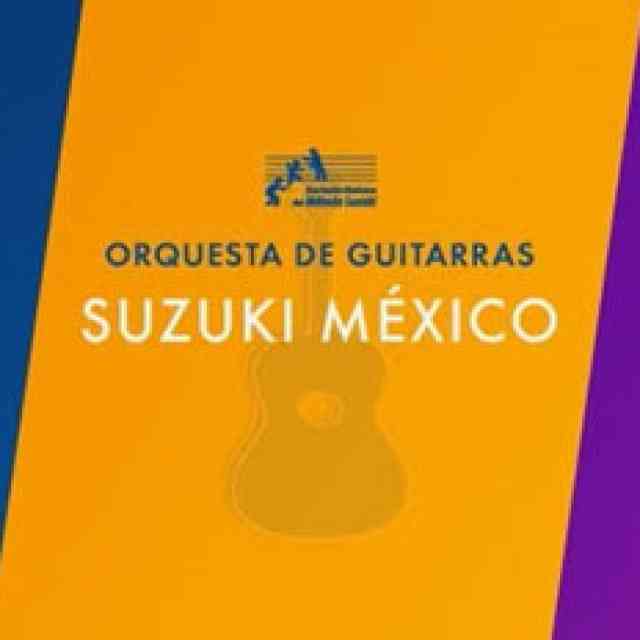
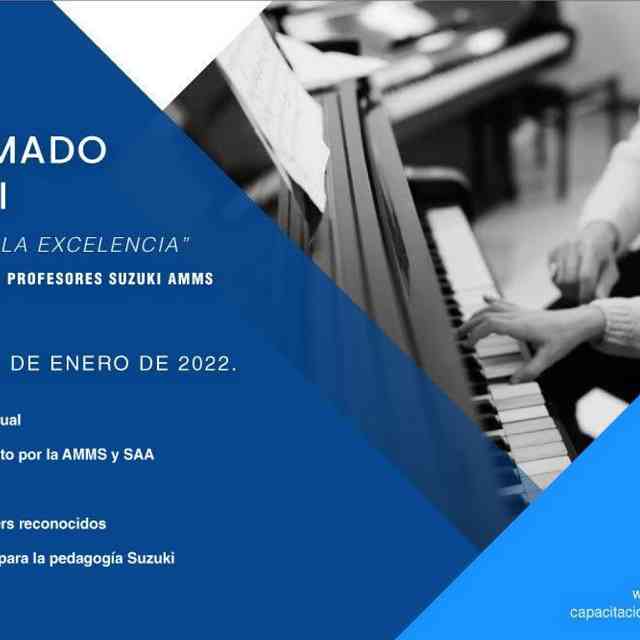
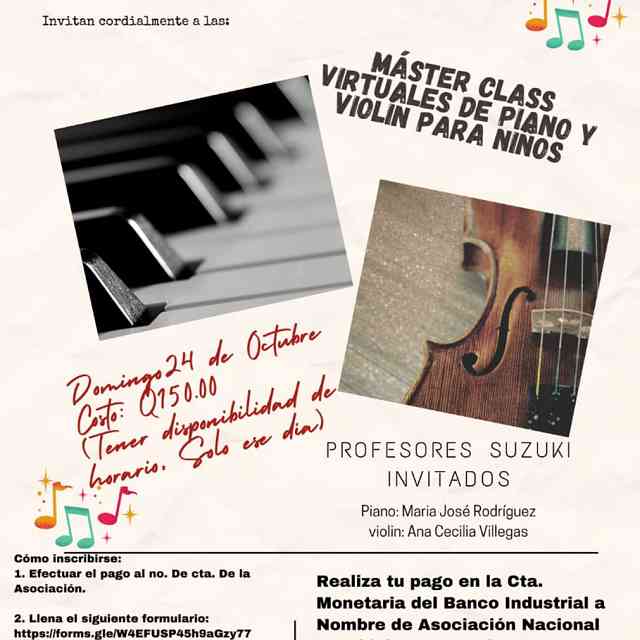





Comments